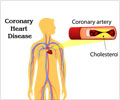A strong association has been identified between tiny genetic molecules called microRNAs and imminent heart attack risk, reveals study.

"About half of all heart attacks occur in patients with no previous signs of heart disease. The heart attack is a surprise, and very often it's deadly," says Jeffrey L. Anderson, MD, chief of cardiovascular research at the Intermountain Medical Center Heart Institute and one of the study's authors. "This project has a lot of promise in helping us develop a way to identify these patients who don't show any obvious signs but are at imminent risk of suffering a heart attack."
The research group from Intermountain Medical Center, the flagship facility for the Intermountain Healthcare system, examined blood samples for the presence of six microRNA molecules that had previously been identified in patients after a heart attack. These genetic structures serve as an "on-off switch" for regulating the expression of a host of genes. When their levels drop, the genes they help to control are no longer regulated and can go "rogue."
The blood samples came from 85 patients who were sorted into four groups:
- Pre-heart attack patients, whose blood was drawn one to seven days before a heart attack
- Post-heart attack patients, whose blood was drawn within 36 hours after a heart attack
- Patients with cardiac problems, but no heart attack within one year before or after blood sample collection
- Healthy patients with no cardiac problems
"We found that three of those six microRNA molecules were present in significantly lower levels in patients who had a heart attack within the next seven days compared to the two groups who didn't have a heart attack," says Oxana Galenko, who holds a doctorate in biomedical science and is lead author of the study.
Advertisement
"We don't know exactly which genes are controlled by these microRNAs, but this study gives us a good starting point for looking more deeply into the ways they influence the heart," says John Carlquist, PhD, director of Intermountain Healthcare's Cardiovascular Molecular and Genetic Laboratory at LDS Hospital and one of the study's authors.
The group says this study was possible only at Intermountain Healthcare, which helped to pioneer computerized health data collection in the 1950s and continues today. Intermountain is home to the world's largest cardiovascular DNA and plasma bank repository, which includes samples from more than 20,000 consenting patients. Combining these resources allowed researchers to search medical records for patients who had a heart attack and also had a frozen blood sample in storage that was drawn in the days before the heart attack.
"Because of this trove of patient records and specimens, we're uniquely equipped to do a study like this," says Dr. Carlquist.
The group will continue their research into microRNAs and heart attack with another study looking at a larger sample of patients, says Dr. Galenko.
Source-Eurekalert














